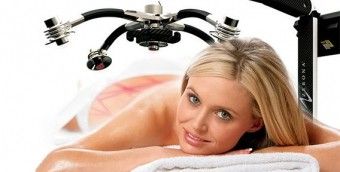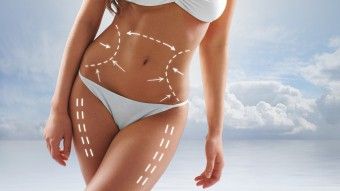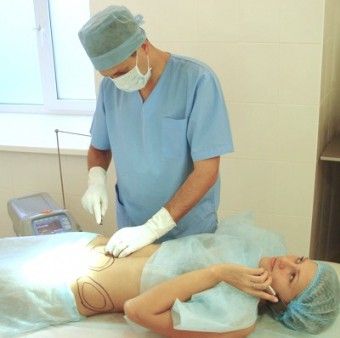Hip liposuction is one of the most popular procedures in aesthetic medicine and plastic surgery. With its help, you can quickly get rid of local fat deposits in the most “problem” zone of the female body.
Purpose of operation
The essence of its application is the selective removal of parts of subcutaneous fat, where the largest accumulation of lipid cells is concentrated. The surgeon applies small punctures to the treated area, and then introduces special miniature cannulas into them for subsequent removal using a special vacuum device.
The classical operation of liposuction implies a full surgical intervention with general anesthesia and a fairly long rehabilitation.
However, in an era of widespread progress, medicine also does not stand aside, and now in cosmetology more gentle methods of correction of a female figure are used. For example, laser liposuction of the hips, during which the lipid fiber is destroyed by precisely directed light radiation, and the destroyed fat cells are removed from the body through traditional metabolic processes.
Many of us saw terrifying photos of the “results” of such a plastic surgery, which gave rise to a lot of myths and “horror stories” around it. In some unfortunate patients, unattractive ripples and tuberosity on the skin manifested themselves trite, others were even less fortunate, because they were faced with suppuration and the formation of fistulas. Needless to say, how many patients of plastic surgeons died on their tables as a result of anaphylactic shock?
But all these things are the exception rather than the rule. The first two examples are the result of the negligence of the operating doctor, and the third, the most fatal, strangely enough, occurs through the fault of the patients themselves.

Looking at the photo of a quality before and after liposuction of the hips, we can only envy the lucky ones who quickly and easily coped with the hated fatty deposits. And this wonderful effect is a direct merit of competent, sensible and conscientious doctors..
The most important factors you should know about liposuction
In this material, we decided to post the most common misconceptions related to the liposuction procedure, so that you have an idea of what you are going for and don’t listen too much to “compassionate” friends.
Myth No. 1. After liposuction, terrible scars remain on the body.

Any self-respecting plastic surgeon uses high-quality self-absorbable suture material, which also does not leave “stitches” on the body. This operation does not involve cuts in principle.
But if you, deciding on liposuction of the hips and buttocks, are panicky afraid of even those same punctures, we recommend you alternative methods of local figure correction:
- Laser liposuction
- Ultrasonic (cavitation) liposuction;
- Vacuum liposuction;
- Injections “Aqualyx” (“Aqualyx”);
- Mesotherapy Injections.
It should also be remembered that minor scarring of the skin after plastic surgery can be easily neutralized by fractional resurfacing..
Myth No. 2. All fat removed during the operation is returned to other places.
Reality: This item is hard to call false in the full sense of the word. In the process of fat removal, the structure of the subcutaneous fat itself is not disturbed, but the eliminated lipid cells really return to their place for a very long time.

Thus, a lazy lady can really provoke a disharmonious redistribution of fats. But nevertheless, this is extremely rare, since the vast majority of patients regard liposuction not at all as a salvation from all ills, but as a powerful motivational impetus to further improve the figure.
In addition, patients who are prone to fullness are often offered a combined procedure, for example, simultaneous liposuction of the abdomen and hips. Therefore, this statement cannot be unambiguously attributed to myths or realities..
Myth No. 3. Mounds and ripples on the skin are mandatory side effects after liposuction.
Reality: No, no, no, and again no! This misconception has given rise to the emergence of many surgeons, whose hands are clearly not growing from traditional places. Yes, such a defect is indeed observed in some women after classical liposuction, but it is associated not with the procedure itself, but with a negligent and inappropriate technique.

Special attention should be paid to the so-called “shares” on plastic. It’s one thing if they are carried out by eminent surgeons with the aim of attracting new patients, and it’s quite another when they are offered by beginners who have just graduated from educational institutions.
What conclusions can we come to?
The main thing is to choose a good doctor, especially if you want to get decent results and maintain your health.
In this regard, liposuction of the inner thigh surface deserves special attention – only a real “jeweler” can do it adequately, who is well acquainted with cosmetic and other minimally invasive methods of face and body correction. You should not save on operations: remember – you put at stake not only your beauty, but also life!

And of course, a lot depends on your behavior during the rehabilitation process. If you ignore all your doctor’s personal recommendations, you’ll likely spoil even your perfectly done work.
Indications and contraindications for surgery
The fight against body fat is almost always a subjective, “personal” indication. However, there are cases when liposuction is carried out for therapeutic or preventive purposes (for example, when it is impossible to carry out surgery due to abdominal obesity).
Liposuction is indicated if:
- You are well aware of such a concept as “fat traps”, or hard-to-reach spots with lipid depots, which are not corrected in the usual way in the form of diets and sports;
- You despaired of exhausting yourself with hunger strikes, and no measures bring the result you need;
- You are ready to adhere to proper nutrition and normalize your physical activity after the procedure;
- You absolutely objectively believe that the only defect in your body is your hips (buttocks / stomach / arms / double chin);
- You are ready for a long enough and laborious rehabilitation process with many prohibitions and warnings.
If all of the above is familiar to you, start your search for a good surgeon..
The liposuction procedure is strictly contraindicated in such conditions:
- Diabetes mellitus in decompensated insulin-dependent form;
- Coagulation disorders (hemophilia);
- Chronic diseases of the internal organs in the acute stage;
- Autoimmune disorders;
- Severe systemic (in particular, endocrine) pathologies;
- Oncological processes;
- Pregnancy and active lactation;
- The tendency to form keloid scars.
If you firmly decided to subject your body to surgical intervention with the aim of its point correction, we can only wish you a competent surgeon and good luck on the way to your goal. Be slim and healthy!











